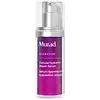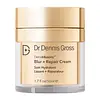What's inside
What's inside
 Key Ingredients
Key Ingredients

 Benefits
Benefits

 Concerns
Concerns

 Ingredients Side-by-side
Ingredients Side-by-side

Water
Skin ConditioningGlycerin
HumectantPentylene Glycol
Skin ConditioningVaccinium Myrtillus Seed Oil
Skin ConditioningC14-22 Alcohols
Emulsion StabilisingPersea Gratissima Oil
Skin ConditioningLactobacillus Ferment
Skin ConditioningSalix Alba Extract
Skin ConditioningZanthoxylum Bungeanum Fruit Extract
Skin ConditioningSodium Hyaluronate Crosspolymer
HumectantHexapeptide-9
Skin ConditioningUrea
BufferingYeast Amino Acids
HumectantTrehalose
HumectantInositol
HumectantTaurine
BufferingBetaine
HumectantHydroxyacetophenone
AntioxidantTocopherol
AntioxidantOleyl Alcohol
EmollientEthylhexylglycerin
Skin ConditioningPullulan
C12-20 Alkyl Glucoside
EmulsifyingSclerotium Gum
Emulsion StabilisingLysolecithin
EmulsifyingXanthan Gum
EmulsifyingSilica
AbrasiveGlucose
HumectantLeuconostoc/Radish Root Ferment Filtrate
AntimicrobialTetrasodium Glutamate Diacetate
Sodium Hydroxide
BufferingChlorphenesin
AntimicrobialLimonene
PerfumingLinalool
PerfumingParfum
MaskingWater, Glycerin, Pentylene Glycol, Vaccinium Myrtillus Seed Oil, C14-22 Alcohols, Persea Gratissima Oil, Lactobacillus Ferment, Salix Alba Extract, Zanthoxylum Bungeanum Fruit Extract, Sodium Hyaluronate Crosspolymer, Hexapeptide-9, Urea, Yeast Amino Acids, Trehalose, Inositol, Taurine, Betaine, Hydroxyacetophenone, Tocopherol, Oleyl Alcohol, Ethylhexylglycerin, Pullulan, C12-20 Alkyl Glucoside, Sclerotium Gum, Lysolecithin, Xanthan Gum, Silica, Glucose, Leuconostoc/Radish Root Ferment Filtrate, Tetrasodium Glutamate Diacetate, Sodium Hydroxide, Chlorphenesin, Limonene, Linalool, Parfum
Water
Skin ConditioningEthylhexyl Palmitate
EmollientIsopropyl Palmitate
EmollientGlycerin
HumectantCaprylic/Capric Triglyceride
MaskingButyrospermum Parkii Butter
Skin ConditioningPropanediol
SolventGlyceryl Stearate Se
EmulsifyingCetearyl Alcohol
EmollientSodium Hyaluronate
HumectantEctoin
Skin ConditioningSodium Hyaluronate Crosspolymer
HumectantPalmitoyl Tetrapeptide-7
Skin ConditioningPalmitoyl Tripeptide-1
Skin ConditioningHeptapeptide-6
Skin ConditioningSodium Acetylated Hyaluronate
HumectantHydrolyzed Sodium Hyaluronate
Skin ConditioningResveratrol
AntioxidantLinolenic Acid
CleansingLinoleic Acid
CleansingCeramide NP
Skin ConditioningCeramide AP
Skin ConditioningCeramide EOP
Skin ConditioningPhytosphingosine
Skin ConditioningPhospholipids
Skin ConditioningLeontopodium Alpinum Callus Culture Extract
AntioxidantSimmondsia Chinensis Seed Oil
EmollientAvena Sativa Kernel Oil
Skin ConditioningSqualane
EmollientSaccharide Isomerate
HumectantAdenosine
Skin ConditioningDimethyl Isosorbide
SolventEthylhexylglycerin
Skin ConditioningPentylene Glycol
Skin ConditioningButylene Glycol
HumectantCetearyl Glucoside
EmulsifyingSodium Stearoyl Glutamate
CleansingGlyceryl Undecylenate
EmollientGlyceryl Caprylate
EmollientCaprylyl Glycol
EmollientCholesterol
EmollientCarbomer
Emulsion StabilisingCoco-Glucoside
CleansingSodium Lauroyl Lactylate
EmulsifyingAmmonium Acryloyldimethyltaurate/Vp Copolymer
Sodium Lactate
BufferingHydroxyapatite
AbrasiveSodium Hydroxide
BufferingSodium Polyacrylate
AbsorbentXanthan Gum
EmulsifyingChlorphenesin
AntimicrobialSodium Citrate
BufferingCitric Acid
BufferingSodium Gluconate
Skin ConditioningPhenoxyethanol
PreservativeWater, Ethylhexyl Palmitate, Isopropyl Palmitate, Glycerin, Caprylic/Capric Triglyceride, Butyrospermum Parkii Butter, Propanediol, Glyceryl Stearate Se, Cetearyl Alcohol, Sodium Hyaluronate, Ectoin, Sodium Hyaluronate Crosspolymer, Palmitoyl Tetrapeptide-7, Palmitoyl Tripeptide-1, Heptapeptide-6, Sodium Acetylated Hyaluronate, Hydrolyzed Sodium Hyaluronate, Resveratrol, Linolenic Acid, Linoleic Acid, Ceramide NP, Ceramide AP, Ceramide EOP, Phytosphingosine, Phospholipids, Leontopodium Alpinum Callus Culture Extract, Simmondsia Chinensis Seed Oil, Avena Sativa Kernel Oil, Squalane, Saccharide Isomerate, Adenosine, Dimethyl Isosorbide, Ethylhexylglycerin, Pentylene Glycol, Butylene Glycol, Cetearyl Glucoside, Sodium Stearoyl Glutamate, Glyceryl Undecylenate, Glyceryl Caprylate, Caprylyl Glycol, Cholesterol, Carbomer, Coco-Glucoside, Sodium Lauroyl Lactylate, Ammonium Acryloyldimethyltaurate/Vp Copolymer, Sodium Lactate, Hydroxyapatite, Sodium Hydroxide, Sodium Polyacrylate, Xanthan Gum, Chlorphenesin, Sodium Citrate, Citric Acid, Sodium Gluconate, Phenoxyethanol
Ingredients Explained
These ingredients are found in both products.
Ingredients higher up in an ingredient list are typically present in a larger amount.
Chlorphenesin is a synthetic preservative. It helps protect a product against bacteria in order to extend shelf life. In most cases, Chlorphenesin is paired with other preservatives such as phenoxyethanol and caprylyl glycol.
Chlorphenesin is a biocide. This means it is able to help fight the microorganisms on our skin. It is also able to fight odor-releasing bacteria.
Chlorphenesin is soluble in both water and glycerin.
Studies show Chlorphenesin is easily absorbed by our skin. You should speak with a skincare professional if you have concerns about using Chlorphenesin.
Learn more about ChlorphenesinEthylhexylglycerin (we can't pronounce this either) is commonly used as a preservative and skin softener. It is derived from glyceryl.
You might see Ethylhexylglycerin often paired with other preservatives such as phenoxyethanol. Ethylhexylglycerin has been found to increase the effectiveness of these other preservatives.
Glycerin is already naturally found in your skin. It helps moisturize and protect your skin.
A study from 2016 found glycerin to be more effective as a humectant than AHAs and hyaluronic acid.
As a humectant, it helps the skin stay hydrated by pulling moisture to your skin. The low molecular weight of glycerin allows it to pull moisture into the deeper layers of your skin.
Hydrated skin improves your skin barrier; Your skin barrier helps protect against irritants and bacteria.
Glycerin has also been found to have antimicrobial and antiviral properties. Due to these properties, glycerin is often used in wound and burn treatments.
In cosmetics, glycerin is usually derived from plants such as soybean or palm. However, it can also be sourced from animals, such as tallow or animal fat.
This ingredient is organic, colorless, odorless, and non-toxic.
Glycerin is the name for this ingredient in American English. British English uses Glycerol/Glycerine.
Learn more about GlycerinPentylene glycol is typically used within a product to thicken it. It also adds a smooth, soft, and moisturizing feel to the product. It is naturally found in plants such as sugar beets.
The hydrophilic trait of Pentylene Glycol makes it a humectant. As a humectant, Pentylene Glycol helps draw moisture from the air to your skin. This can help keep your skin hydrated.
This property also makes Pentylene Glycol a great texture enhancer. It can also help thicken or stabilize a product.
Pentylene Glycol also acts as a mild preservative and helps to keep a product microbe-free.
Some people may experience mild eye and skin irritation from Pentylene Glycol. We always recommend speaking with a professional about using this ingredient in your routine.
Pentylene Glycol has a low molecular weight and is part of the 1,2-glycol family.
Learn more about Pentylene GlycolSodium Hyaluronate Crosspolymer is a type of hyaluronic acid. In fact, it is modified version of hyaluronic acid.
The structure of Sodium Hyaluronate Crosspolymer allows it to stay in the skin's top layer for a longer period of time. This allows for even more hydration and humectant action than hyaluronic acid.
These are some other common types of Hyaluronic Acid:
Learn more about Sodium Hyaluronate CrosspolymerSodium Hydroxide is also known as lye or caustic soda. It is used to adjust the pH of products; many ingredients require a specific pH to be effective.
In small amounts, sodium hydroxide is considered safe to use. However, large amounts may cause chemical burns due to its high alkaline.
Your skin has a natural pH and acid mantle. This acid mantle helps prevent harmful bacteria from breaking through. The acid mantle also helps keep your skin hydrated.
"Alkaline" refers to a high pH level. A low pH level would be considered acidic.
Learn more about Sodium HydroxideWater. It's the most common cosmetic ingredient of all. You'll usually see it at the top of ingredient lists, meaning that it makes up the largest part of the product.
So why is it so popular? Water most often acts as a solvent - this means that it helps dissolve other ingredients into the formulation.
You'll also recognize water as that liquid we all need to stay alive. If you see this, drink a glass of water. Stay hydrated!
Learn more about WaterXanthan gum is used as a stabilizer and thickener within cosmetic products. It helps give products a sticky, thick feeling - preventing them from being too runny.
On the technical side of things, xanthan gum is a polysaccharide - a combination consisting of multiple sugar molecules bonded together.
Xanthan gum is a pretty common and great ingredient. It is a natural, non-toxic, non-irritating ingredient that is also commonly used in food products.
Learn more about Xanthan Gum